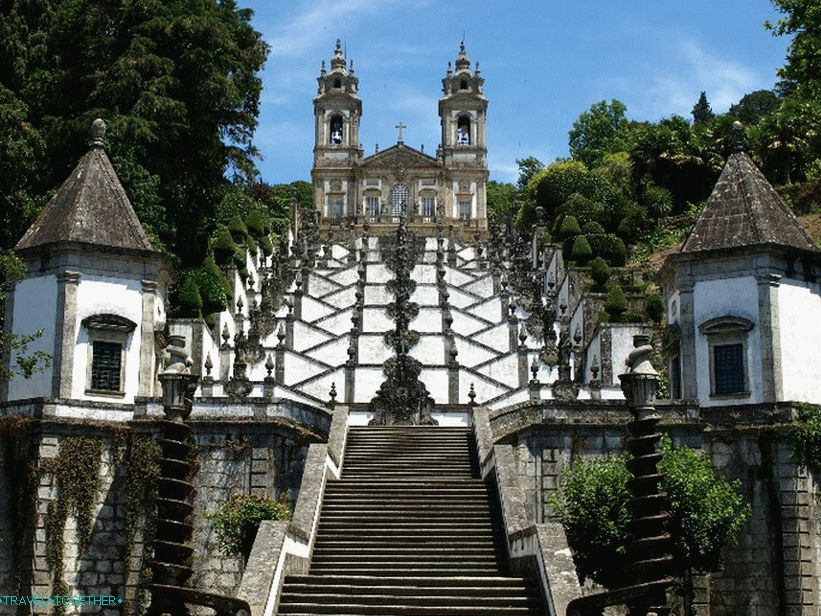Braga (Portugal) – the most detailed information about the city with photos. The main attractions of Braga with descriptions, guides and cards.
Contents
Braga City (Portugal)
Braga is one of the largest cities in Portugal, located in the heart of the fertile province of Minho on northwest of the country. Famous for its magnificent granite mansions. 18th century, a whole scattering of stunning old churches, beautiful parks and gardens. Braga – one of the oldest cities Portugal and its religious capital known for its solemn atmosphere and luxurious baroque architecture.
Thanks to the ancient history and the many monuments of sacral Braga’s architecture is often called “Portuguese Rome”.
- Geography and climate
- Practical information
- Story
- sights
- Video
- Maps and guides
- Comments and reviews
Geography and climate
Braga is located in northern Portugal in the transition region between its east and west. The city is located in the valley of the river Eshti picturesque area surrounded by hills and forests. Braga has humid subtropical climate with hot summers and mild winters, and also frequent westerly winds.
Braga is located 321 km north of Lisbon and 50 km from Porto.
 Braga
Braga
Practical information
- The population is more than 190 thousand people.
- The area is 183.51 km².
- Currency – Euro.
- The language is Portuguese.
- Visa – Schengen.
- Time – UTC 0, in the summer +1.
- The easiest way to get to Braga is to take advantage Porto Airport. The city also has a regular railway communication with Lisbon and Porto.
- Braga is famous for a large number of inexpensive restaurants. Most of them are located in the eastern part of the city in the area university.
Story
The settlement on the site of modern Braga was founded in the era Iron Age. In the 5th – 3rd century BC tribes settled here brakar (celts). In 20 BC on the site of the ancient Celtic The settlement was built by the Roman city of Bracara Augusta, which became nodal point of five roman roads. After the collapse of the Roman Empire Braga became the capital of the Svev kingdom. Later city on For three centuries belonged to the Visigoths.
 Old street in Brahe
Old street in Brahe
The first bishopric here was founded at the beginning of the 5th century. In 715 Braga was conquered by the Moors. Although under Arab influence the city was not for long. After some time, Braga subdued Afonso III from the Burgundian dynasty. Between 1093 and 1147 the city was the residence of the Portuguese court. During the Reconquista Braga was one of the main centers of Christianity in Iberia. AT further prosperity of the city was associated with the bishopric, which is reflected in numerous examples of sacred architecture.
 Church on top Bom jes do monte
Church on top Bom jes do monte
sights
The old city of Braga is famous for the scattering of magnificent gothic and Baroque churches, as well as 18th century mansions. But the city offers far more attractions than just endless ancient temples. The historical center of Braga is practically completely pedestrian and consists of charming squares, beautiful old streets and landscaped gardens.
 Se
Se
Ce is a magnificent cathedral founded in the 11th century. is he was built on the site of an early Romanesque church that was completely destroyed in the 16th century. The cathedral was expanded to later century and now is a building that mixes several architectural styles. The most remarkable elements its structures are towers in the style of Manueline architecture of the 15th century. Inside the cathedral contains several old gothic chapels tombs and many beautiful wooden elements.
On Rua Dom Paio Mendes is a museum of sacred architecture, which contains magnificent collections of religious works arts: ancient statues, carvings and beautiful style tiles Azulezhu.
 Palace archbishops
Palace archbishops
Archbishops’ Palace – a historic building of the 14th century not far from the cathedral with a beautiful view of the picturesque garden.
Museu dos Biscainhos on Rua dos Biscainhos, which is located in beautiful noble mansion of the 18th century. Represents collections Roman relics, antique furniture and works art.
 Bom jes do monte
Bom jes do monte
Bom Jesus do Monte – the most impressive religious monument Portugal It is an extraordinary baroque escalation of the 18th. centuries and monumental granite stairs that lead to a beautiful neoclassical church. Also this sanctuary is decorated with fountains, statues of biblical saints and chapels. This magnificent monument located 6 km east of Braga.
On Rua dos Bombeiros Voluntários is a small an archeological museum that exhibits early Braga’s stories.

The Idol Fountain is an unusual monument of the Roman era. Presents a granite fountain built over a water source (presumably in the 1st century BC).
 San Frutuoso de Montelios
San Frutuoso de Montelios
San Frutuoso de Montelios (Capela São Frutuoso de Montélios) – graceful chapel which is one of the oldest christian buildings in Portugal. Originally a religious building here was built in the 7th century. Then it was destroyed by the Moors and rebuilt in the 10th century. The chapel is located 3 km northwest of center of braga
 Nossa senora up Sameiro
Nossa senora up Sameiro
Nossa Senhora do Sameiro – 19th century neoclassical building located on a high hill to south of bom jesus do monte.
 Porta nova
Porta nova
Porta Nova – an arch of the 18th century, built on the site of a medieval passage that connected the city with the adjacent village.
 Tower Menaghem
Tower Menaghem
The Menagem Tower is all that remains of a medieval castle, which was mentioned at the beginning of the 14th century.
 Church Misicordia
Church Misicordia
The church of Misericordia is a 16th century church that is important heritage of the Renaissance and has an impressive carved baroque altar.
 Papule church
Papule church
Papal Church is a beautiful neoclassical church founded in the 16th century and rebuilt in the 18th century.
 Basilica Kongregadosh
Basilica Kongregadosh
Kongregosh Basilica – Baroque church, started in 18 century and completed in the 1960s (which is why the building has elements of rococo and neoclassicism).
 Carmo Church
Carmo Church
The Carmo Church is a neoclassical church that was part of 17th century Carmelite monastery.
 Holy Church Cross
Holy Church Cross
The Church of the Holy Cross is a beautiful Baroque building dating from 17 century.

Church of sv. Vincent is a magnificent 17th century baroque church, built on the site of an ancient religious building of the 7th century (period of the Visigoths).
Video
Maps and guides
Tourist Card






